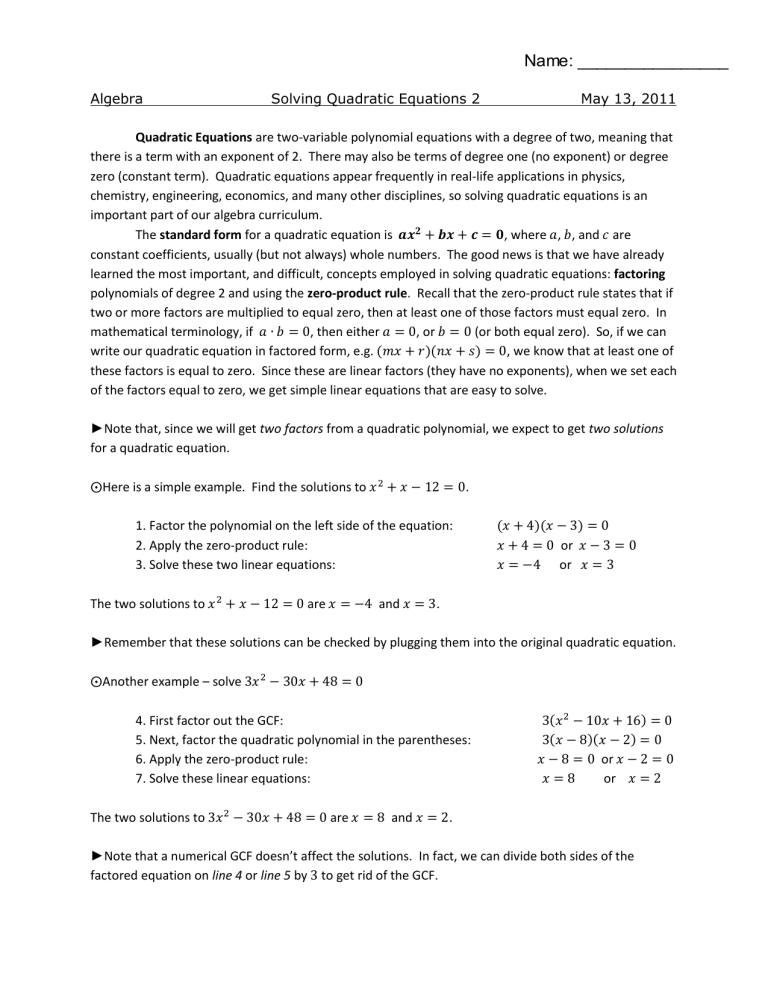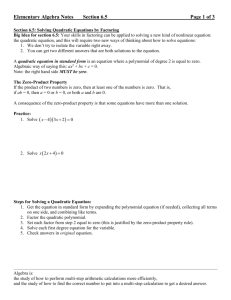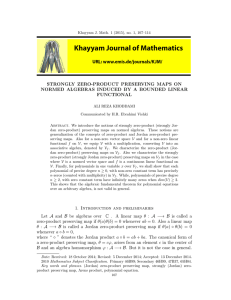Worksheet - Quadratic Equations 2 (Reg)

Name: ________________
Algebra Solving Quadratic Equations 2 May 13, 2011
Quadratic Equations are two-variable polynomial equations with a degree of two, meaning that there is a term with an exponent of 2. There may also be terms of degree one (no exponent) or degree zero (constant term). Quadratic equations appear frequently in real-life applications in physics, chemistry, engineering, economics, and many other disciplines, so solving quadratic equations is an important part of our algebra curriculum.
The standard form for a quadratic equation is 𝒂𝒙
𝟐
+ 𝒃𝒙 + 𝒄 = 𝟎 , where 𝑎 , 𝑏 , and 𝑐 are constant coefficients, usually (but not always) whole numbers. The good news is that we have already learned the most important, and difficult, concepts employed in solving quadratic equations: factoring polynomials of degree 2 and using the zero-product rule. Recall that the zero-product rule states that if two or more factors are multiplied to equal zero, then at least one of those factors must equal zero. In mathematical terminology, if 𝑎 ∙ 𝑏 = 0 , then either 𝑎 = 0 , or 𝑏 = 0 (or both equal zero). So, if we can write our quadratic equation in factored form, e.g. (𝑚𝑥 + 𝑟)(𝑛𝑥 + 𝑠) = 0 , we know that at least one of these factors is equal to zero. Since these are linear factors (they have no exponents), when we set each of the factors equal to zero, we get simple linear equations that are easy to solve.
► Note that, since we will get two factors from a quadratic polynomial, we expect to get two solutions for a quadratic equation.
⨀ Here is a simple example. Find the solutions to 𝑥
2
+ 𝑥 − 12 = 0 .
1. Factor the polynomial on the left side of the equation:
2. Apply the zero-product rule:
(𝑥 + 4)(𝑥 − 3) = 0 𝑥 + 4 = 0 or 𝑥 − 3 = 0
3. Solve these two linear equations:
The two solutions to 𝑥 2 + 𝑥 − 12 = 0 are 𝑥 = −4 and 𝑥 = 3 . 𝑥 = −4 or 𝑥 = 3
► Remember that these solutions can be checked by plugging them into the original quadratic equation.
⨀ Another example – solve 3𝑥 2 − 30𝑥 + 48 = 0
4. First factor out the GCF:
7. Solve these linear equations:
3(𝑥
2
− 10𝑥 + 16) = 0
5. Next, factor the quadratic polynomial in the parentheses:
6. Apply the zero-product rule:
3(𝑥 − 8)(𝑥 − 2) = 0 𝑥 − 8 = 0 or 𝑥 − 2 = 0 𝑥 = 8 or 𝑥 = 2
The two solutions to 3𝑥 2 − 30𝑥 + 48 = 0 are 𝑥 = 8 and 𝑥 = 2 .
► Note that a numerical GCF doesn’t affect the solutions. In fact, we can divide both sides of the factored equation on line 4 or line 5 by 3 to get rid of the GCF.
⨀ Here’s a third example – solve 𝑥
3
+ 15𝑥
2
+ 50𝑥 = 0
8. First factor out the GCF, 𝑥 :
9. Factor the polynomial:
10. Apply the zero-product rule: 𝑥(𝑥
2 𝑥 = 0
+ 15𝑥 + 50) = 0 𝑥(𝑥 + 5)(𝑥 + 10) = 0
or 𝑥 + 5 = 0 or 𝑥 + 10 = 0
11. Find the solutions: 𝑥 = 0 or 𝑥 = −5 or 𝑥 = −10
The three solutions to 𝑥
3
+ 15𝑥
2
+ 50𝑥 = 0 are 𝑥 = 0, −5, −10 .
► Note that this equation starts out with degree of three (it has an 𝑥 3
term), and we end up with three solutions. The GCF of 𝑥 produces the solution 𝑥 = 0 . In general, we will only solve degree 3 equations when we can factor out 𝑥 to simplify the equation to a quadratic (degree 2) equation.
⨀ Finally, how can we solve an equation like 𝑥 2 = 4𝑥 + 5 ? Since this equation is not in standard form, we must first do an additional step to get all terms on the left side, leaving zero on the right side.
12. Subtract
13. Factor:
4𝑥 + 5 from both sides: 𝑥 2 − 4𝑥 − 5 = 0
(𝑥 − 5)(𝑥 + 1) = 0
14. Zero-product rule:
15. Solve: 𝑥 − 5 = 0 𝑥 = 5
or
or 𝑥 + 1 = 0 𝑥 = −1
► Here is a summary of the steps used to solve quadratic equations by factoring:
1. Get all terms on one side of the equation, set equal to zero.
2. Factor out a GCF if possible.
3. Factor the quadratic polynomial.
4. Use the zero-product rule.
Solve these quadratic equations in class:
1. 𝑥 2 + 8𝑥 = 0
5. Find solutions by solving the simpler linear equations.
2. 𝑥 2 = 3𝑥
3. 𝑥 2 + 12𝑥 + 35 = 0 4. 5𝑥 2 − 15𝑥 − 50 = 0
5. 𝑥 2 − 9𝑥 = −20 6. 𝑥 = 30 − 𝑥 2
Name: ________________
Homework: solve these quadratic equations by factoring.
7. 𝑥 2 + 14𝑥 = 0
9. 𝑥
2
− 2𝑥 − 3 = 0
11. 𝑥 2 + 7𝑥 − 18 = 0
13. 𝑥
2
= 16𝑥 − 60
15. 𝑥 2 + 10𝑥 = −25
17. 5𝑥 = 24 − 𝑥
2
8. 𝑥 2 − 11𝑥 + 24 = 0
10. 𝑥
2
+ 𝑥 − 56 = 0
12. 𝑥 2 − 5𝑥 − 6 = 0
14. 𝑥
2
= 20 − 𝑥
16. 𝑥 2 − 4𝑥 = 32
18. 44 − 7𝑥 = 𝑥
2
19. 6𝑥
2
= 24𝑥 − 18
21. 2 𝑥
2
+ 5𝑥 + 3 = 0
23. 2𝑥 2 + 7 = 15𝑥
25. 2𝑥
2
= 𝑥 + 10
27. 3𝑥
2
+ 8𝑥 = 2𝑥
2
− 15
20. 30 = 3𝑥
2
+ 9𝑥
22. 3𝑥
2
+ 𝑥 = 4
24. 𝑥 3 + 3𝑥 2 − 10𝑥 = 0
26. 2𝑥
3
+ 70𝑥 = 24𝑥
2
28. 14 + 2𝑥 − 𝑥
2
= 11𝑥 − 2𝑥
2









